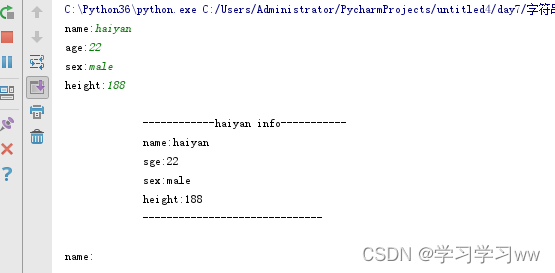数字类型和字符串类型
1.bin()函数将十进制转换成而进制
2.oct()函数将十进制转换成八进制
3.hex()函数将十进制转换成十六进制
十六进制表示:0-9 a b c d e f
4.数字类型的特性:
只能存放一个值
一经定义,不可更改
直接访问
分类:整型,布尔,浮点,复数
5.字符串类型
引号包含的都是字符串类型
S1=‘hello world’ s=“hello world”
s2=“”“hello world”“”
s3=‘’‘hello world’‘’
单引双引没有区别
6.字符串的常用操作
strip()移除空白,也可以去除其他的字符
slipt()分割,默认以空格分割。也可以以其他的字符分割
len()长度 切片:如print(x[1:3])也是顾头不顾尾
print(x[0:5:2])#0 2 4
capitalize()首字母大写
center()居中显示例如:x=‘hello’ print(x.center(30,‘#’))
count():计数,顾头不顾尾,统计某个字符的个数,空格也算一个字符
endswith()以什么结尾
satrtswith()以什么开头
find()查找字符的索引位置,如果是负数,代表查找失败
index()索引
find()和index()的区别,如下图:

format()字符串格式化
1.msg=‘name:{},age:{},sex:{}’
print(msg.format(‘haiyan’,18,女))
2.msg=‘name:{0},age:{1},sex:{0}’
print(msg.format(‘aaaaaa’,‘bbbbbb’))
3.msg=‘name:{x},age:{y,sex:{z}’
print(msg.format(x=‘haiyan’,y=‘18’,z=‘女’))
isdigit()判断是否是数字
islower()判断是否是全部小写
isupper()判断是否是全部大写
lower()全部转换为小写
upper()全部转换为大写
isspace()判断是否是全都是空格
istitle()判断是否是标题(首字母大写)
swapcase()大小写字母翻转
join()连接
repalce()替换
msg=‘hello alex’
print(msg.replace(‘e’),‘A’,1)
print(msg.replace(‘e’),‘A’,2)
ljust()左对齐
X=‘ABC’ print(x.ljust(10,‘*’))
字符串格式化及字符串的一些方法
1.%s,%d
举例1:name=‘egon’
age=20
print(“my name is %s my age is %s” %(name,age))#%s既能接受字符串,也能接受数字
print(‘my name is %s my age is %d’ %(name,age))#%d只能接受数字
举例2:用户信息的显示
复制代码
1 while True:
2 name=input(“name:”)
3 age=input(“age:”)
4 sex=input(“sex:”)
5 height=input(“height:”)
6 msg=‘’’
7 ------------%s info-----------
8 name:%s
9 age:%s
10 sex:%s
11 height:%s
12 ------------------------------
13 ‘’'%(name,name,age,sex,heigth)
14 print(msg)
复制代码
运行结果如下:
while True:
name=input("name:")
age=input("age:")
sex=input("sex:")
height=input("height:")
msg='''
------------%s info-----------
name:%s
age:%s
sex:%s
height:%s
------------------------------
'''%(name,name,age,sex,heigth)
print(msg)

2.字符串方法

name=‘egon’ #name=str(‘egon’)
print(type(name))
#优先掌握
#1.移除空白strip
msg=’ hello ’
print(msg)
print(msg.strip())
移除‘*’
msg=‘hello******’
msg=msg.strip(‘*’)
print(msg)
#移除左边的
print(msg.lstrip(‘*’))
#移除右边的
print(msg.rstrip(‘*’))
#用处
while True:
name=input('user: ').strip()
password=input('password: ').strip()
if name == ‘egon’ and password == ‘123’:
print(‘login successfull’)
#切分split
info=‘root❌0:0::/root:/bin/bash’
print(info[0]+info[1]+info[2]+info[3])
user_l=info.split(‘:’)
print(user_l[0])
msg=‘hello world egon say hahah’
print(msg.split()) #默认以空格作为分隔符
#cmd=‘download|xhp.mov|3000’
cmd_l=cmd.split(‘|’)
print(cmd_l[1])
print(cmd_l[0])
print(cmd.split(‘|’,1))
#用处
while True:
cmd=input('>>: ').strip()
if len(cmd) == 0:continue
cmd_l=cmd.split()
print(‘命令是:%s 命令的参数是:%s’ %(cmd_l[0],cmd_l[1]))
#长度len
print(len(‘hell 123’))
#索引
切片:切出子字符串
msg=‘hello world’
print(msg[1:3]) #1 2
print(msg[1:4]) #1 2 3
掌握部分
oldboy_age=84
while True:
age=input('>>: ').strip()
if len(age) == 0:
continue
if age.isdigit():
age=int(age)
else:
print(‘must be int’)
#startswith,endswith
name=‘alex_SB’
print(name.endswith(‘SB’))
print(name.startswith(‘alex’))
#replace
name=‘alex say :i have one tesla,my name is alex’
print(name.replace(‘alex’,‘SB’,1))
print(‘my name is %s my age is %s my sex is %s’ %(‘egon’,18,‘male’))
print(‘my name is {} my age is {} my sex is {}’.format(‘egon’,18,‘male’))
print('my name is {0} my age is {1} my sex is {0}:
{2}'.format(‘egon’,18,‘male’))
print(‘my name is {name} my age is {age} my sex is {sex}’.format(
sex=‘male’,
age=18,
name=‘egon’))
name=‘goee say hello’
# print(name.find(‘S’,1,3)) #顾头不顾尾,找不到则返回-1不会报错,找到了则显示索引
# print(name.index(‘S’)) #同上,但是找不到会报错
print(name.count(‘S’,1,5)) #顾头不顾尾,如果不指定范围则查找所有
#join
info=‘root❌0:0::/root:/bin/bash’
print(info.split(‘:’))
l=[‘root’, ‘x’, ‘0’, ‘0’, ‘’, ‘/root’, ‘/bin/bash’]
print(‘:’.join(l))
#lower,upper
name=‘eGon’
print(name.lower())
print(name.upper())
#了解部分
#expandtabs
name=‘egon\thello’
print(name)
print(name.expandtabs(1))
#center,ljust,rjust,zfill
name=‘egon’
# print(name.center(30,‘-’))
print(name.ljust(30,‘*’))
print(name.rjust(30,‘*’))
print(name.zfill(50)) #用0填充
#captalize,swapcase,title
name=‘eGon’
print(name.capitalize()) #首字母大写,其余部分小写
print(name.swapcase()) #大小写翻转
msg=‘egon say hi’
print(msg.title()) #每个单词的首字母大写
#在python3中
num0=‘4’
num1=b’4’ #bytes
num2=u’4’ #unicode,python3中无需加u就是unicode
num3=‘四’ #中文数字
num4=‘Ⅳ’ #罗马数字
#isdigt:str,bytes,unicode
print(num0.isdigit())
print(num1.isdigit())
print(num2.isdigit())
print(num3.isdigit())
print(num4.isdigit())
#isdecimal:str,unicode
num0=‘4’
num1=b’4’ #bytes
num2=u’4’ #unicode,python3中无需加u就是unicode
num3=‘四’ #中文数字
num4=‘Ⅳ’ #罗马数字
print(num0.isdecimal())
# print(num1.)
print(num2.isdecimal())
print(num3.isdecimal())
print(num4.isdecimal())
#isnumeric:str,unicode,中文,罗马
num0=‘4’
num1=b’4’ #bytes
num2=u’4’ #unicode,python3中无需加u就是unicode
num3=‘四’ #中文数字
num4=‘Ⅳ’ #罗马数字
print(num0.isnumeric())
# print(num1)
print(num2.isnumeric())
print(num3.isnumeric())
print(num4.isnumeric())
#is其他
name=‘egon123’
print(name.isalnum()) #字符串由字母和数字组成
name=‘asdfasdfa sdf’
print(name.isalpha()) #字符串只由字母组成
name=‘asdfor123’
print(name.isidentifier())
name=‘egGon’
print(name.islower())
print(name.isupper())
print(name.isspace())
name=‘Egon say’
print(name.istitle())








 本文详细介绍了Python中的数字类型和字符串操作,包括转换进制、字符串的常用方法如strip、split、len、切片等,以及字符串格式化、大小写转换和数字的属性检查等。通过实例展示了各种操作的使用,帮助读者深入理解Python的基础数据类型。
本文详细介绍了Python中的数字类型和字符串操作,包括转换进制、字符串的常用方法如strip、split、len、切片等,以及字符串格式化、大小写转换和数字的属性检查等。通过实例展示了各种操作的使用,帮助读者深入理解Python的基础数据类型。

















 1771
1771

 被折叠的 条评论
为什么被折叠?
被折叠的 条评论
为什么被折叠?










